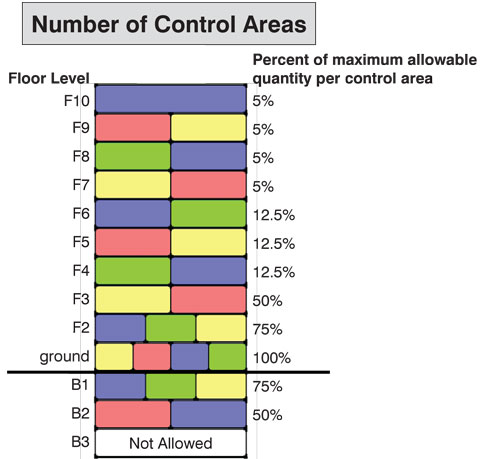Hazardous Materials 102: Control Areas

7 years, 3 months ago
NOTE: This is the second installment in a multipart series on hazardous materials in industrial facilities. Part 101 can be found here, while Part 103 can be referenced here.

By Ellen McCulley, AIA, LEED AP, NCARB
Nelson Design, Inc.
Hazardous Materials 101 outlined how to identify, quantify, and determine the usage of hazardous materials in your facility. Once that process is completed and hazardous materials are present, the next step is to assess if the total quantity of hazardous materials exceeds the maximum allowable quantity per control area. Control areas allow a limited quantity of hazardous materials to be located within an area without having a high hazard occupancy classification. It is preferable to utilize control areas because a high hazard occupancy classification adds difficult compliant requirements for the facility and thus the cost of construction to meet regulations.
Table 5003.1.1(1) in the 2015 International Fire Code (IFC) specifies the maximum allowable quantity per control area of hazardous materials posing a physical hazard. Table 5003.1.1(2) defines the maximum quantity for health hazards. (The same tables are included in 307.1(1) and 307.1(2) in the International Building Code). Both tables identify the maximum quantities based on the type of hazard and the usage (storage, use-closed systems, or use-open systems) and physical state (solid, liquid, gas) of the material. When reviewing the table to access the allowable quantities, it is important to pay attention to the footnotes. Each table has footnotes that allow the maximum quantity to be increased by one hundred percent if the building is sprinklered throughout and/or if the hazardous materials is stored in an approved storage cabinet, gas cabinet, or exhausted enclosure. If both are applicable, the increase may be applied cumulatively.
If the allowable quantity is not exceeded the compliance requirements are greatly reduced. However, both the International Building Code and International Fire Code dictate special requirements when any amount of hazardous materials is present, regardless of occupancy classification. An example of these requirements includes: submission of a hazardous materials report to the Authority Having Jurisdiction (AHJ), explosion control, spill control, and secondary containment in certain situations.
If the allowable quantity is exceeded there are three options. The first is to determine if the hazard meets one of the exceptions included under the definition of High-Hazard Group H in section 202 of the IFC. A few of these exceptions include: refrigeration systems, closed piping systems containing flammable or combustible liquids or gases used for the operation of machinery or equipment, and stationary batteries under certain circumstances.
The second option to compliance if the allowable quantity is exceeded is to regulate the use of hazardous materials into multiple control areas in order to not surpass the permitted amounts per control area. Table 5003.8.3.2 defines the requirements for the design and number of control areas. The table includes the number of control areas based on the floor, the percentage of maximum allowable quantity per control area, and the fire resistance rating required between control areas. Please refer to the Control Area Limitations diagram for a summary of the requirements.
If the first two options are not possible then the area containing the hazardous materials must be classified as a high hazard occupancy.
ABOUT THE AUTHOR
Ellen McCulley graduated magna cum laude with a Bachelor of Architecture from Iowa State University where she received the Pella Architectural Award from the Department of Architecture. She is a registered architect in Iowa and Illinois. Ms. McCulley joined Carl A. Nelson & Company in 2012. Learn more by calling Ellen at 319-754-8415, or write to canco@carlanelsonco.com.